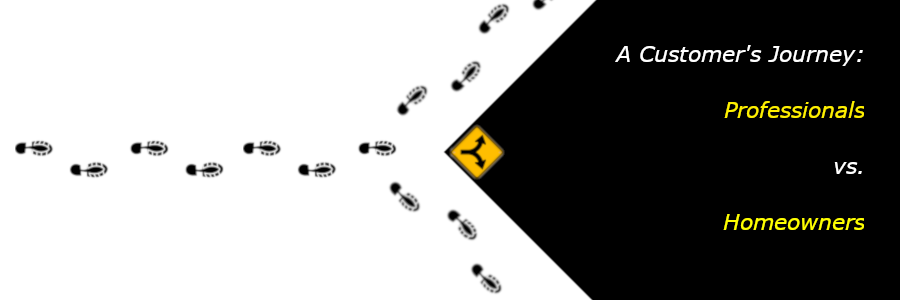A Customer’s Journey: Professionals vs. Homeowners
by Black Ink Team

There are countless ways to advertise/sell your products, but thankfully there're only so many ways that customers will buy them. Keeping track of customer data and sales data is crucial to identifying behavioral patterns that will lead to increased revenue. A useful tool for doing this is CRM. With a CRM, you can look at customers' purchase histories in aggregate which allows you to make powerful marketing insights. Without one, you'd have to spend weeks just cleaning the data and getting it into the right format in order to achieve the same results. To find strategies that will help you in the future, study what happened in the past.
Grouping your customers into separate categories is useful because then you can isolate certain characteristics for certain market segments. This enables you to spend your marketing budget more wisely. For example, millennials are in general more likely to respond to digital advertising than Baby Boomers, so you should tailor your digital ads to suit a younger crowd. In addition, grouping your customers helps you fine-tune your customer profiles. In other words, if you know some customers are of a similar type, you can compare their data to find more similarities - which will help you target other customers like them in the future.
If you are an equipment dealer, two distinct groups of customers you should keep in mind are 'professionals' and 'homeowners.' Professional customers are businesses who usually buy the same equipment periodically. They are power-users and therefore their equipment requires a lot replacement parts. Homeowners are people who are buying equipment for personal, relatively-light use. They tend to outsource their maintenance/repair needs. The reasons you want to separate customers into these two categories (at least) are that they respond to different selling tactics, they're interested in different products, and they demand different experiences.
Professionals respond to loyalty programs designed to reward them for repeat business. An example of this would be to extend to a professional a deal that if they buy two pieces of the same equipment in a year, you will sell them a third at a discounted price. It may sound counter-intuitive, to give discounts to who your biggest customers are, but look at it from a balance sheet perspective - it pays to have customers who are consistent and reliable, even if they are discounted, because then you can forecast more accurately.
Professionals also respond positively when dealers give them a priority status. Say a professional deck building company has a pretty good idea of how much wood they will need in a given month. Their supplier could charge them a fee, and guarantee that they will keep that much in stock until the deck builder buys it.
Professionals do not expect to go to a retail location and check out at the register - they expect to start a business-to-business relationship. As large amounts of money are trading hands, professionals may want to speak directly with the head manager. In addition, they may want to negotiate a contract face-to-face.
Homeowners are interested in products that are easier to use/maintain, for instance electric- or battery-powered outdoor power equipment. Also, homeowners respond to promotions that grant them discounts on cross-purchases (purchases of items from different product categories) because then they can save money on filling their shed.
Homeowners expect to go to a retail location and test out products hands-on. They also expect to talk to a salesperson who is knowledgeable about the products they want to buy. Both of these elements help with their decision-making and put them at ease. A warehouse can hold more to sell, but you sell more with a showroom.
As soon as you have your customers grouped based on whether they are professionals or homeowners, you can analyze which are the best ways to sell to either category. One method of doing this is called 'A/B Testing.' This is where you implement two changes to your business (change 'A' and change 'B') and calculate which had the best ROI. CRM can make marketing experimentation like this a breeze.
